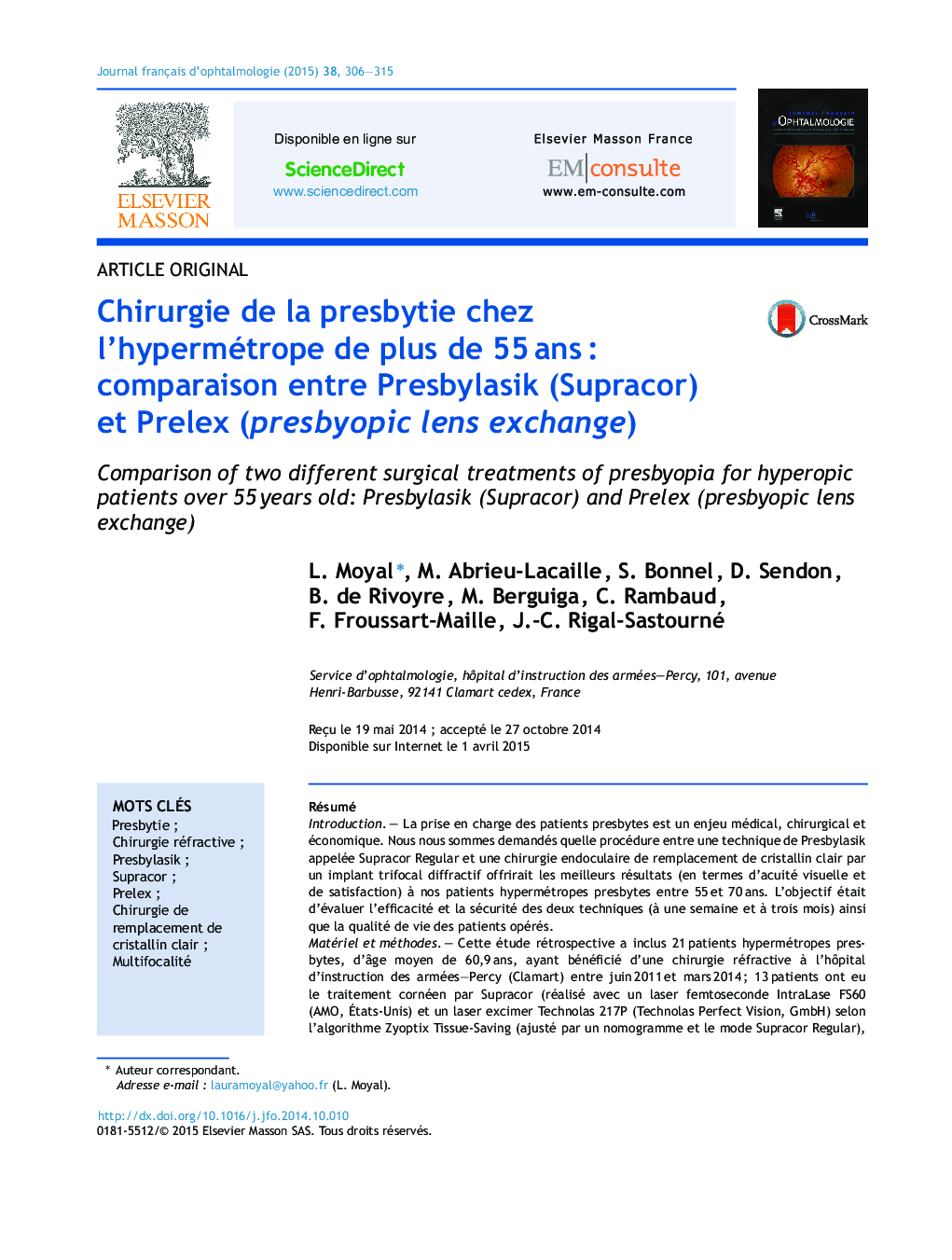| کد مقاله | کد نشریه | سال انتشار | مقاله انگلیسی | نسخه تمام متن |
|---|---|---|---|---|
| 4023412 | 1262268 | 2015 | 10 صفحه PDF | دانلود رایگان |

RésuméIntroductionLa prise en charge des patients presbytes est un enjeu médical, chirurgical et économique. Nous nous sommes demandés quelle procédure entre une technique de Presbylasik appelée Supracor Regular et une chirurgie endoculaire de remplacement de cristallin clair par un implant trifocal diffractif offrirait les meilleurs résultats (en termes d’acuité visuelle et de satisfaction) à nos patients hypermétropes presbytes entre 55 et 70 ans. L’objectif était d’évaluer l’efficacité et la sécurité des deux techniques (à une semaine et à trois mois) ainsi que la qualité de vie des patients opérés.Matériel et méthodesCette étude rétrospective a inclus 21 patients hypermétropes presbytes, d’âge moyen de 60,9 ans, ayant bénéficié d’une chirurgie réfractive à l’hôpital d’instruction des armées–Percy (Clamart) entre juin 2011 et mars 2014 ; 13 patients ont eu le traitement cornéen par Supracor (réalisé avec un laser femtoseconde IntraLase FS60 (AMO, États-Unis) et un laser excimer Technolas 217P (Technolas Perfect Vision, GmbH) selon l’algorithme Zyoptix Tissue-Saving (ajusté par un nomogramme et le mode Supracor Regular), et 8 patients ont bénéficié d’une chirurgie de cristallin clair Prelex (presbyopic lens exchange) par phacoémulsification bimanuelle avec mise en place d’implants intraoculaires trifocaux diffractifs Finevison Micro F, PhysIOL*.RésultatsL’acuité visuelle binoculaire sans correction dans le groupe Supracor est de 0,03 (−0,2–0,1) LogMar en vision de loin et 0,23 (0,06–0,36) en vision de près à j7 et de 0,031 (−0,2–0,1) en VL et 0,166 (0,06–0,36) en VP à 3 mois. Dans le groupe Prelex, à j7, l’AVSC binoculaire est de 0,025 (0–0,1) en VL et 0,165 (0,06–0,18) en VP et à m3 de 0 (−0,1–0,1) en VL et 0,105 (0,06–0,18) en VP. Quatre patients du groupe Supracor restent dépendants de lunettes en vision de près versus 0 dans le groupe Prelex. Sept patients sur 11 du groupe Supracor et 100 % des patients Prelex sont pleinement satisfaits. La présence de halos lumineux est retrouvée dans les deux techniques. Le taux de reprise est plus important dans le groupe Supracor, mais la reprise est plus lourde dans le groupe Prelex.ConclusionLes deux procédures chirurgicales sont efficaces et sûres pour la prise en charge des patients hypermétropes et presbytes. Cependant, pour les patients âgés de plus de 55 ans, la chirurgie cristallinienne semble être la plus appropriée.
SummaryIntroductionThe management of presbyopic patients is a medical, surgical and economic issue. We wondered which procedure, whether a Presbylasik technique called Regular Supracor or the intraocular surgery of clear lens replacement by a trifocal diffractive lens (presbyopic lens exchange [Prelex]), provided the best results (in visual acuity and satisfaction) for our hyperopic and presbyopic patients between 55 and 70. The aim of this study was to compare the safety and efficacy of the two techniques (at one week and three months) and to assess patients’ quality of life.MethodsThis study is a retrospective monocentric clinical trial conducted between June 2011 and March 2014, on 21 hyperopic presbyopic patients (mean age 60.9 years), in the “hôpital d’instruction des armées–Percy” (Clamart); 13 patients underwent the corneal treatment of Presbylasik (with the Intralase FS60 femtosecond laser [AMO, USA] and the Technolas 217P excimer laser [Technolas Perfect Vision, GmbH] following the Zyoptix Tissue-Saving algorithm adjusted with a nomogram and the Regular Supracor mode), and 8 patients underwent clear lens extraction (Prelex), through bimanual phacoemulsification and implantation of diffractive trifocal intraocular lenses (Finevision Micro F, PhysIOL*).ResultsMean uncorrected binocular distance and near vision visual acuity in the Supracor group were respectively 0.03 (−0.2–0.1) LogMar and 0.23 (0.06–0.36) one week postoperatively and 0.031 (−0.2–0.1) and 0,166 (0.06–0.36) three months postoperatively. In the Prelex group, the mean uncorrected one week binocular VA was 0.025 (0–0.1) for distance vision and 0.165 (0.06–0.18) for near distance and the three months visual acuity was 0 (−0.1–0.1) and 0.105 (0.06–0.18) for distance and near vision. All Prelex patients were spectacle-free at all distances, whereas 4 Supracor patients required spectacles for near vision postoperatively. Seven of 11 patients in the Supracor group and 100% of the Prelex patients were completely satisfied. Both groups experienced halos, but patients reported more halos in the Prelex group (75%). One eye required intraocular lens exchange and four eyes (16.7%) required a new corneal procedure in the Supracor group.ConclusionBoth surgeries are safe and effective modalities in the management of hyperopic and presbyopic patients. However, the Prelex procedure seems to be more appropriate for patients over 55 years of age.
Journal: Journal Français d'Ophtalmologie - Volume 38, Issue 4, April 2015, Pages 306–315